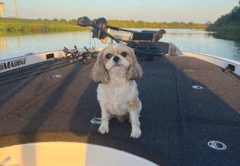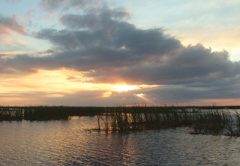By Don Norton
It was just about an hour after daybreak, on the 4th of July, in 1943, when Jim Jacobs, owner of the Triple T cattle ranch on old route 98, just south of Lorida, Florida, checked on his herd. He normally rode the northern stretch of his 500-acre spread with Toby, one of his oldest ranch hands, but he had decided to go by himself today. Most of his men were taking the day off to enjoy the festivities in Sebring, and he planned to go into town later in the day. He had been a cattle rancher all his life, and when his daddy died in ’38, he’d inherited the ranch. He couldn’t imagine doing anything else.
He had ridden out to the southeast ridge, near an oxbow in the Kissimmee River when he spotted the half-eaten carcass of one of his prized steers. As he neared the bloated body, he sensed danger as he reached for his gun. There was movement in the tall grass near the edge of the water.
It wasn’t unusual to lose a calf, or even a cow in the marshy water along the shoreline of the river. He figured they’d lost three or four every year. But this was an exceptionally large steer, and it was half-eaten. It would have taken something exceptionally large to take down a twelve-hundred-pound steer, and then to eat half of it. Maybe it was a large cougar. There were a few of them around, although he hadn’t seen any indication that one was in the area. But a cougar, no matter how big it was couldn’t have eaten half a steer. Maybe a bear, he thought.
Climbing down from Nellie, he suspected a pair of cougars, or maybe bears, as he reached for his old .44 magnum, holstered on his side. His old man had carried that gun for years and seldom ever fired it, but Jim practiced with it often and kept it clean as a whistle. Drawing the gun, he could see that Nellie was scared. She’d been his favorite horse for years and she seldom ever showed fear. Once, when she was much younger, she stomped to death a den of rattlesnakes, saving her life and Jim’s. Whatever took down that steer was close by. And she knew it.
As he neared the edge of the water, buzzards were circling in the sky. Looking and listening, Jim could see where the steer had been taken down. There was blood everywhere. Grass and weeds were flattened to the ground, and it looked like the big animal had been dragged ten or twelve feet towards the waters edge. Without warning, Nellie reared her front legs, as he turned around and watched in horror as a huge alligator attacked her from behind. With a death grip on her hindquarters, the beast was able to pull her down. Kicking and snorting, she fell on her side with the big gator holding firmly to her hind legs. Jim fired three shots into the side of the gator, careful not to hit Nellie. His aim was perfect, but the big gator seemed unfazed.
He could see that it was a huge alligator. Or was it a crocodile? He wasn’t sure. He’d seen both and occasionally a large gator would attack a calf or one of his neighbor’s sheep, but he’d never heard of one attempting to take down a full-grown steer, let alone a horse. This was a true monster. Certainly, the largest gator/croc he’d ever seen. He knew alligators were common along the shore of the Kissimmee River, as well as Lake Okeechobee and Lake Istokpoga, but crocodiles never came this far north. On some days it wasn’t unusual to see dozens of gators basking in the sun. They seldom bothered his livestock.
He had seen crocodiles before when he’d made a trip to the Thousand Islands in the Everglades with his dad, but never here, he thought, and he had always heard that they didn’t get along very well with the gator population. Whatever this thing was, it was huge. The creature flipped Nellie over as it bit deeper into her hind legs and hip, attempting to drag her towards the water.
He fired a couple more shots, trying desperately to kill the beast or at least make it let go of Nellie. He knew to kill a gator, you had to place the kill shot literally right between its eyes. But he couldn’t get a good shot. Fearing that he’d miss and hit Nellie, he continued to fire into the belly and back of the beast. It didn’t seem to have much of an effect, until suddenly, the monster let go of Nellie, glaring ferociously as it looked back at him.
Later, as Jim recounted the tale to his ranch hands, he said he could not tell if the shots had hurt the animal or just made it angry. Either way, it began to move menacingly toward Jim as he fired repeatedly.
Alligators and crocodiles can move amazingly fast on land, and even given the huge size of this creature, it was quickly closing in on him.
Just as he was braced for the attack, another creature, even larger than the first came rushing out of the tall grass and struck the smaller gator just behind the front legs. The second gator was at least five feet longer than the first and the two wrestled and fought as they rolled towards the water’s edge. The smaller of the two, suffering deep cuts along its side, broke away from the death grip of the larger creature and quickly dove deep into the river. The huge beast that had inadvertently saved Jim’s life, triumphant in the battle, followed after it, looking to finish the fight. Jim was in shock. He quickly reloaded his revolver and helped Nellie back to her feet.
She was bleeding pretty badly from her hip, the bone shining brightly white against the afternoon sun, and Jim knew he had to get her back to the barn and get a vet over to patch her up. She would survive, despite the huge gashes in her hip and legs.
Watching over his shoulder as they walked away, he would never forget the enormous size and shape of that second alligator. Was it a gator or a croc? He just could not tell for sure. Whatever it was, he hoped their paths would never cross again.
A few weeks later when he met with a few of the other ranchers at a town hall meeting in Sebring, they too had seen something that resembled the monster Jim described, but none had been that close. They could not agree on whether it was an alligator or a crocodile, or some other prehistoric beast. But they could agree that whatever it was it was close to twenty-five feet long and weighing close to a ton. They all knew that alligators did not get that big. Nor did crocodiles. It had to be some kind of hybrid or maybe it wasn’t either. Maybe it was some kind of dinosaur left over from the past.
Years went by before another incident occurred. Unlike Jim’s run-in with the creature on land at the edge of the Kissimmee River, this time it happened to a fisherman on Lake Istokpoga. There were many stories about what happened on that day in 1945. Some said it was just a wild story, something made up to scare people. But others knew the victim, and they believed the story to be true.
It seemed that old Doc Whitley, a retired pediatrician in Lake Placid had launched his small wooden rowboat at Windy Point on Lake Istokpoga that day, hoping to catch a few crappies for the dinner table. At 82, Ron was still in surprisingly good shape, but his daughter worried about him out on the lake by himself.
When he didn’t get home for lunch, she got worried. Then, missing dinner was the last straw. That evening, she went to the sheriff’s office after dark to report that her dad had never made it home.
The sheriff and a few of his deputies drove down to Windy Point and found his old beat-up Ford parked under one of the sprawling oak trees. No other vehicles were there and even in the darkness, there was no sign of movement anywhere. The sheriff attempted to reassure his daughter that he probably got tired and decided to camp out on one of the islands, even though he knew that was pretty unlikely. He suspected that the old-timer had had a heart attack and died alone on the water. He promised her that they would look for him in the morning.
An hour before sunrise they organized a search party and they found his boat around eight a.m. in a small cove at the bottom of Bumblebee Island, probably pushed into the reeds by the wind. The boat was still partially afloat but overturned and the stern was gone, or at least a couple feet of it. There was no sign of the doctor.
Further investigation showed huge, deep cuts into the wooden structure of the boat, indicating something exceptionally large had bitten into the boat. One of the deputies who had worked in Miami said it looked like a Great White Shark had attacked the craft. But sharks lived in saltwater. It couldn’t have been a shark. They all looked at each other. Could an alligator have attacked him while he was fishing? It seemed pretty unlikely. And how big would an alligator have to be in order to bite off a couple feet of a boat? The sheriff scratched his head as they continued to search the area.
They spent five days scouring the lake and the islands. The only thing they ever found was an old straw hat that may or may not have belonged to the doctor. It was partially shredded, but still floated. The body was never found. Stories soon circulated that a monster alligator or crocodile was roaming the lake, searching for its next meal. Fishermen began carrying shotguns and rifles on their fishing trips.
Stories soon resurfaced about Jim Jacobs and his run-in with the big gator a few years earlier. It wasn’t long before people began reporting incidents of seeing the monster in both Okeechobee and Lake Istokpoga. One report came from an elderly lady who thought she saw the monster lazily swimming along in Lake June, only to discover it was a group of kids on floating rafts.
One of the local boys, having just read about one of the great Roman mythological characters, Hercules, took it upon himself to name the beast. Hercules was no longer a myth.
*The book Hercules – The Terror of the Ridge is part of a trilogy of three books; Queenie – The Legend of Lake Istokpoga; and “The Old Man,” and will be available in September 2024







